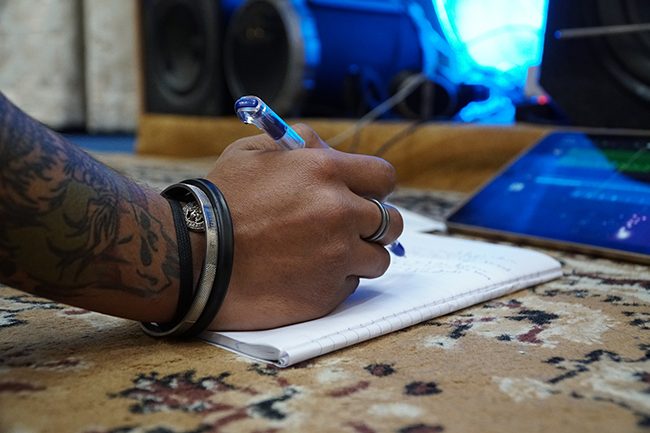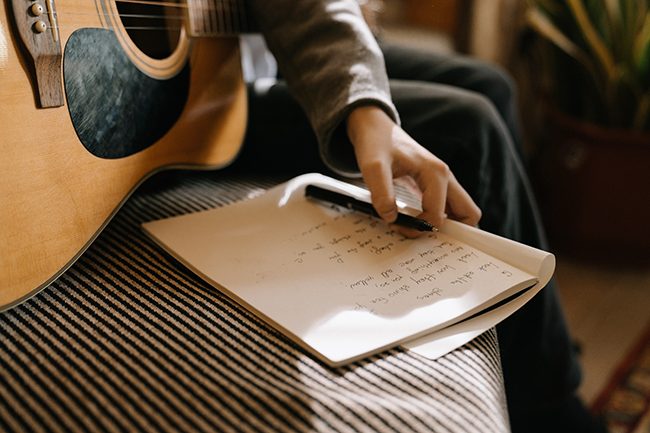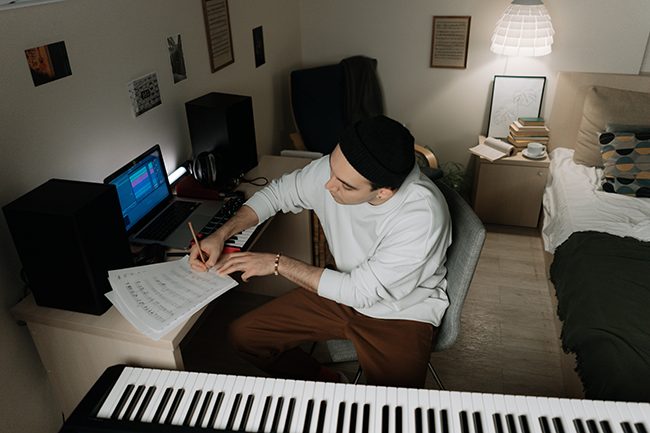
Are you trying to learn how to write a song but don’t know where to start? Don’t panic! Contrary to popular belief, just about anyone can write a song as long as they have a few pointers to set them off on the right track.
It can take years to become a masterful songwriter, but you’ll be able to pump out your very first tune by the end of this article. Without further ado, let’s dive into nine songwriting steps for beginners and experienced musicians alike.

Ready to put pen to paper? Here’s an easy way to write your first song. Just remember that every songwriter is different, and these steps serve as a starting guideline for anyone new to songwriting, but it isn’t always a linear process. Give yourself the freedom to experiment and find a method that works for you. You simply can’t go wrong as long as you’re writing songs!
Seek Out Inspiration, Don’t Wait For It
Many times, we stop ourselves from writing a song or creating a piece of music because we don’t feel that “spark.” While it’s undeniable that some of the best pieces of music are created from spontaneous inspiration, remember that songwriting is a skill just like anything else. That means it takes plenty of practice for it to become second nature for you. It means that those coveted “sparks” will become more common if you’re willing to work through dull periods.
Hence, the first step of songwriting is choosing to get started. If you’re already inspired to write about something, that’s great! Pick your topic and move on to the next step. However, if you’re struggling to land on a solid song idea, try out one of these strategies to spark up some ideas:
- Find inspiration in other music. Think about what types of music you connect with the most. What are those songs about? What do you connect with most in those songs? Find a song with a message you resonate with, and set out to recreate the same feeling in your own words.
- Write what you know. Try pulling something up from personal experience. You may feel pretty vulnerable at first, but some of the best songs come from true, raw emotions. Let yourself transform your emotions into a concrete song.
- Conjure up a story. Songwriters also wear the storyteller hat, and you can too! Have you consumed any strong stories in movies or books lately? What situation would be most interesting to write about? Some might find it helpful to focus a song around a situation rather than a feeling.
- Take a walk. Some musicians are especially inspired by nature. Taking a walk or even people watching might be just enough to give you something great to write about.
- Pick up your instrument. If you’re an instrumentalist, playing a chord progression or melody line can certainly lead to inspiration. Vocalists can also check out chord progression loops online. There’s no one right way to start a song and it’s entirely possible that the music might come before the lyrics and vice versa.
Once you’ve selected one or more ideas, narrow it down to a single song topic and proceed to the next step.
Let Your Ideas Flow
During this stage of the process, it’s important to tune down your inner self-critic. We all have one of these voices, and while they can be helpful for pushing our music to new heights, they can certainly be more of a hindrance during the brainstorming stage. Save that editing hat for later. You’ll get the chance to edit your song, but for now, you’ll want to let your ideas flow.
It might be helpful to start writing out lyrics in your notes app or on a pad of paper. Now that you have a song topic, start to conjure up phrases and words that relate to that central idea. It can be especially helpful to try and craft lines that rhyme, so feel free to use an online rhyming dictionary as well.
Use your starting topic to build a story, whether that’s with lyrics on their own or with an instrumental.
Capture All Ideas
While you’re building a web around your song’s topic, be sure to capture any and all ideas that come to mind. For example, if you come up with a vocal melody, be sure to record a quick voice memo so that you’ll remember it throughout the writing process. A lot of times, these ideas can be very fickle, so make it your mission to record draft versions of lyrics and melodies that have a chance of making it into your song.
If you find yourself struggling to write lyrics, pull up a chord progression on YouTube or build up a beat first. Create something simple, loop it, and start writing. Some songwriters might find it helpful to write lyrics in the form of a poem first and then work on translating it to music. Don’t worry too much about crafting the perfect line during this stage. If something comes to you, it’s worth recording on voice memos, in writing, over video, or anything in between.

Create Song Structure
Now that you have a bunch of song fragments, it’s time to put together a central structure! Structures vary from track to track, but some of the most common structures include:
- VERSE– PRE CHORUS – CHORUS – VERSE – PRE CHORUS – CHORUS
- INTRO – VERSE – CHORUS – VERSE – BRIDGE – CHORUS
- VERSE – CHORUS – BRIDGE – CHORUS
The Verse is the meat and potatoes of the song. These sections are longer and help shape the story of a particular track. The Chorus is the repetitive, memorable part of the track that often includes a strong melodic hook and the song’s title. The Pre chorus can serve as another memorable melodic section leading up to the bigger chorus. Finally, the Bridge serves as a connection between the final chorus and the rest of the song, oftentimes introducing a new lyrical or melodic idea.
It’s a good idea to stick to one of these basic song structures while you’re getting the hang of songwriting, but there’s no one right way to build out your track. You will notice, however, that most songs have some form of rhyme scheme. This makes lines more interesting and memorable for the listener and can be achieved in multiple ways:
- AAAA: In this rhyme scheme, all lines rhyme in some way with the proceeding line. Think about the verse sections in “Hello” by Adele.
- ABAB: Every other line rhymes with one another in this rhyme scheme. Think about the chorus in “Stay” by The Kid Laroi and Justin Bieber.
- AABB: The first two lines rhyme and the third and fourth lines rhyme. This pattern continues as a series of couplets. Think “Good Ones” by Charli XCX.
Start to take your lyrical and melodic phrases and put them into one of these basic structures. From there, you can tweak lines to build up a strong rhyme scheme that will help your song remain sticky in a listener’s mind long after they hit “play.”

Refine and Rewind
Congratulations! Most of the heavy lifting is done. Now that you’ve built up a strong foundation for your song, you can take out your editing hat. Are there any words you might want to swap out to create a stronger flow? Do you need to edit your backing track or adjust your melodies to better fit the lyrics? Perhaps you need to find a stronger rhyme in the hook of the chorus.
Whatever it may be, now is the time to make those changes. Don’t get discouraged if you realize you may need to take a step back. Some of the best songs of today went through plenty of versions and iterations. Trust that it’s all a part of the songwriting process and bravely make productive changes to your original song ideas.
Seek Out Feedback
If you’re not comfortable sharing your unfinished work with those you personally know, seek out feedback online. There are a ton of free feedback forums via Reddit, Discord, and even TikTok that can be used to pilot new songs. Ask people on these platforms how you can improve and engage in the community yourself to expand your songwriting circle.
Collaborate With Other Musicians
It’s a great idea to bring your ideas to other musicians, especially if you don’t currently create your own instrumentals. If you don’t have a backing track already to sync with your song, seek out collaborators who can help you build one. Having melodic context might bring up new lyrical ideas that you didn’t have previously, plus it is always great practice to work through a song from start to finish.
Moving forward, try to find ways to collaborate with other artists from the get-go. Engaging in writing sessions can help you grow as a musician and provide plenty of insight since you’ll get an inside look at each musician’s writing process. At the end of the day, our ears aren’t always the most reliable narrator, so working with others, especially those more experienced than you, will undoubtedly take your songs to new heights.
Don’t Let Great Be The Enemy Of Good
While it’s always a good idea to take the time to edit your song as needed, remember that it’s not the end of the world if you’re not constantly pumping out radio hits. Even the strongest musicians make average art from time to time, though that doesn’t take away from their strength as a songwriter.
If you’ve worked through your song and made it the best it can be, give yourself a pat on the back and set your sights on the next creation. Quality will come if you’re willing to put in the work with quantity.
Rinse and Repeat!
At the end of the day, the best way to become a great songwriter is to write more songs. You’re not going to get any better if you don’t give yourself the space and time needed to work through your initial creations. Like anything else, songwriting will become easier the more time you dedicate to it, even if this is difficult to foresee in the beginning.
Keep writing on a regular basis. Your first song might not be your best one, but if you keep writing, you’re bound to create a hit in no time at all. Happy writing!

